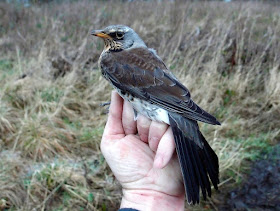I had 3 nets set up just after 8:00am, a 14 m and 18 m in a line by the eastern hedge and a 6 m set in the side of a large willow, with a new Blackbird being caught before I had finished setting up. This was quickly followed by a new Fieldfare, a new Chaffinch, 2 new Goldfinches and 2 retrap Robins in the first full round. The number of finches present increased with the light levels until there was a mixed flock of about 60 visiting the feeders; Goldfinches being the dominant species by far.
 |
| Adult female Fieldfare. |
Enough of the depressing stuff and it was a fairly productive morning despite the paucity of Greenfinches. By the time I packed up, late morning, I had caught 40 new birds and only six retraps with most being caught in the 6 m net. Goldfinches easily took top slot with a very respectable 30 new birds and 3 retraps (originally ringed 15/06/14, 27/04/15 & 18/12/15) making up the bulk of the totals. Had it been calmer I would have probably caught even more but it doesn't seem to take much of a breeze to make the nets by the eastern hedge more obvious and easy for the birds to avoid. Ringing totals for the morning (retraps in brackets) were: Blackbird 2; Fieldfare 1; Robin (2); Blue Tit 1 (1); Chaffinch 3; Greenfinch 3; Goldfinch 30 (3). Total 40 new birds and 6 retraps.
 |
| Male Goldfinch (I doubt anyone would disagree with the sex of this bird) |
 |
| Female Goldfinch (oh yes it is as we are in pantomime season) |
 |
| Male Goldfinch (I doubt anyone would disagree with the sex of this bird either) |
 |
| Male Goldfinch (A mix of red, orange and paler feathers but a male nevertheless) |
 |
| Male Goldfinch (and oh yes it is even though the extent of the red is similar to the female 3 images above) |
 |
| Female Goldfinch This first winter female had a wing length of just over 80 mm (not quite 80.5) so beware if you sex some of your Goldfinches on size or use size to sway you. |
The most numerous species seen during the morning was Pink-footed Goose with at least 800 feeding in and moving between the fields adjacent to the ringing site. The largest flock gathered in a harvested potato field just across the road from the ringing site. Geese that feed in this area seem to be fairly accustomed to people using the footpaths on the adjacent roads and well walked public footpaths and will tolerate a fairly close approach. A large flight of geese is a birding spectacle that is hard to beat and just seeing these geese would have been a great start to the New Year on its own.
Happy New Year






No comments:
Post a Comment